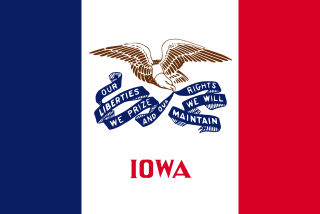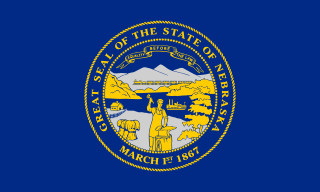
The coat of arms of the state of New York was formally adopted in 1778, and appears as a component of the state's flag and seal.

The flag of Georgia is the flag of the U.S. state of Georgia. Its current iteration was adopted on February 19, 2003. The flag bears three horizontal stripes and features a blue canton containing a ring of 13 white stars that encircle the state's gold-colored coat of arms. The ring of stars that encompass the state's coat of arms represents Georgia as one of the original Thirteen Colonies.

The flag of the state of Michigan is a coat of arms set on a dark blue field, as set forth by Michigan state law. The governor has a variant of the flag with a white field instead of blue one. The state has an official flag month from June 14 through July 14.

The flag of Ontario is the provincial flag of Ontario, Canada. It is a defaced Red Ensign, with the Royal Union Flag in the canton and the Ontario shield of arms in the fly. The flag of Ontario was derived from the Canadian Red Ensign, which was used as a civil ensign and as a de facto flag of Canada from the late 19th century to 1965. It was adopted in a period when many Canadian provinces adopted their own flags. May 21 is Ontario Flag Day.

The flags of the U.S. states, territories, and the District of Columbia exhibit a variety of regional influences and local histories, as well as different styles and design principles. Modern U.S. state flags date from the turn of the 20th century, when states considered distinctive symbols for the 1893 World's Columbian Exposition in Chicago, Illinois. Most U.S. state flags were designed and adopted between 1893 and World War I.

The flag of Alberta is an official symbol of the province of Alberta, Canada. In 1968, the provincial legislature authorized the design of a flag, adopting it on 1 June 1968.

The flag of Arkansas, also known as the Arkansas flag, consists of a red field charged with a large blue-bordered white lozenge (diamond). Twenty-nine five-pointed stars appear on the flag: twenty-five small white stars within the blue border, and four larger blue stars in the white diamond. The inscription "ARKANSAS" appears in blue within the white lozenge, with one star above and three stars below. The star above and the two outer stars below point upwards; the inner star below points downwards. The flag was designed by Willie K. Hocker of Wabbaseka, a member of the Pine Bluff Chapter of the Arkansas Society of the Daughters of the American Revolution.

The flag of the state of Connecticut is a white baroque shield with three grapevines, each bearing three bunches of purple grapes on a field of royal blue. The banner below the shield reads "Qui Transtulit Sustinet", Latin for "He who transplanted sustains", Connecticut's state motto. The flag dimensions are 5.5 feet (1.7 m) in length and 4.33 feet (1.32 m) in width.

The flag of Delaware consists of a buff-colored diamond on a field of colonial blue, with the coat of arms of the state of Delaware inside the diamond. Below the diamond, the date December 7, 1787, declares the day on which Delaware became the first state to ratify the United States Constitution. The colors of the flag reflect the colors of the uniform of General George Washington.

The current flag of Indiana was designed by Paul Hadley and officially adopted by the State of Indiana in May 1917.

The flag of the state of Iowa is a vertical tricolor flag designed by Dixie Cornell Gebhardt in 1917. Iowa, United States legislators officially adopted the flag in 1921.

The Commonwealth of Massachusetts has been represented by official but limited-purpose flags since 1676, though until 1908 it had no state flag per se to represent its government. A variant of the white flag with blue seal was carried by each of the Massachusetts volunteer regiments during the American Civil War alongside the National Colors. An exception were the two "Irish regiments", each of which was permitted to carry an alternative green flag with a harp symbol.

The flag of the state of Montana consists of the image of the Montana state seal centered on a blue field.

The official flag of New Mexico, a subnational polity of the United States, consists of a red sun symbol of the Zia people on a field of gold (yellow). It was officially adopted in 1925 to highlight the state's Native American and Hispano heritage: It combines a symbol of the Puebloan people, who have ancient roots in the state, with the colors of the flag of Spain, which established and ruled Nuevo México for over two and a half centuries.

The flag of Tennessee displays an emblem on a field of red, with a strip of blue bordered by white on the fly. The emblem in the middle consists of three stars on a blue circle also with a white border. The central emblem portion of the flag has been adopted as the state's unofficial logo, and appears in the logos of some Tennessee-based companies and sports teams. Examples include the First Horizon Bank and the Tennessee Titans.

The flag of West Virginia is the official flag of the U.S. State of West Virginia and was officially adopted by the West Virginia Legislature on March 7, 1929. The present flag consists of a pure white field bordered by a blue stripe with the coat of arms of West Virginia in the center, wreathed by Rhododendron maximum and topped by an unfurled red ribbon reading, "State of West Virginia." It is the only state flag to bear crossing rifles, meant to illustrate the importance of the state's fight for liberty during the Civil War as the southern unionist 35th state.

The Seal of the Commonwealth of Kentucky was adopted in December 1792. Since that time, it has undergone several revisions. The current seal depicts two men, one in buckskin, and the other in more formal dress. The men are facing each other and clasping hands. The outer ring of the seal is adorned with the words "Commonwealth of Kentucky", and within the inner circle is the state motto "United we stand, divided we fall." The official colors of the seal are blue and gold. A version of the seal appears on the flag of Kentucky.

The seal of the Territory of Idaho was adopted in 1863 and redrawn several times before statehood in 1890. The first state Great Seal was designed in the 1890s by Emma Edwards Green, the only woman to design a U.S. state seal. That seal was used until 1957, when the seal was slightly redrawn by Paul B. Evans and the Caxton Printers, Ltd. at the request of the state government, in order to add more anthropocentric elements to the centered shield.

The flag of the state of Nebraska is a blue rectangular cloth charged with a variation of the Nebraskan state seal. The current design was commissioned in 1925, when the Nebraska legislature passed a bill stating that the flag would consist of the state seal in gold and silver on a field of blue.






















